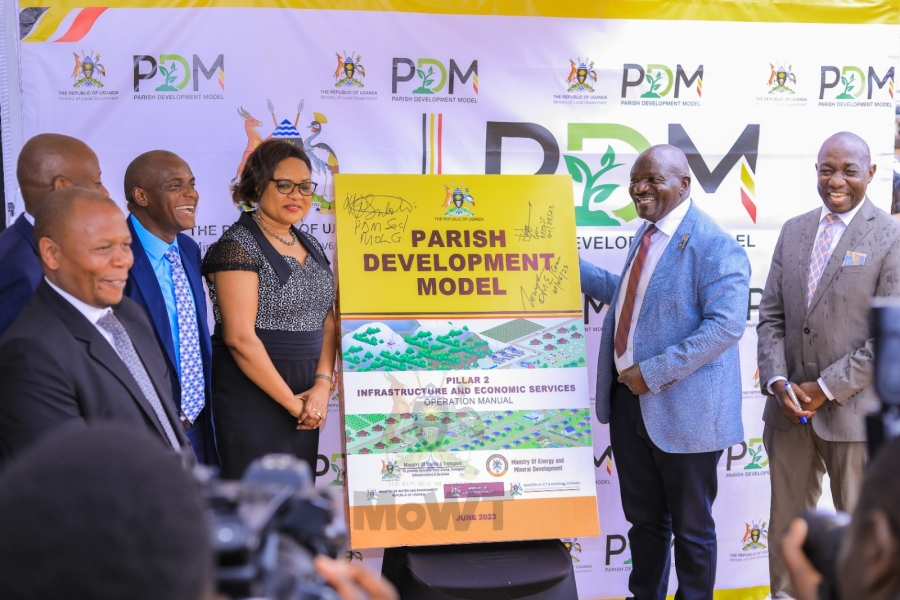Today marks a significant milestone as the Parish Development Model (PDM) Working Group unveils the Infrastructure and Economic Services Operation Manual for Pillar 2. The PDM, a comprehensive development strategy conceived under the Third National Development Plan (NDP III) of Uganda, aims to accelerate the decentralization process, uplift household incomes, and enhance the quality of life for the substantial percentage of Ugandan households still entrenched in subsistence livelihoods.
Pillar 2, Infrastructure and Economic Services, spearheaded by the Ministry of Works and Transport, in collaboration with the Ministry of Energy and Mineral Development, plays a pivotal role in ensuring the provision of reliable infrastructure and economic services for production and marketing. The key ministries associated with Pillar 2 include the Ministry of Water and Environment, the Ministry of Information, Communication and Technology, and National Guidance, the Ministry of Local Government, and the Ministry of Lands, Housing, and Urban Development.
The Minister of Works and Transport, Gen. Katumba Wamala while launching the Operation Manual remarked that the Government of Uganda is committed to the implementation of the Parish Development Model development strategy to ensure that all Ugandans are uplifted into the country’s money economy.
“It is therefore important to the Government to have all MDAs and LGs actively participating and supporting the implementation of key Government programs, all the 7 Pillars complement each other hence the need to have all pillar activities guided, to ensure that they all work towards a common goal,” added the Minister.
As part of Pillar 2's implementation, a set of ten activities have been identified, each led by its respective Key Pillar Ministry. The role of the Pillar 2 Working Group is to ensure alignment between budgets, work plans, and the Pillar 2 activities. The PDM approach adopts a bottom-up methodology, empowering communities to identify their needs, thereby guiding the planning and budgeting cycles of the Pillar Ministries.
On his part, the Engineer in Chief noted that budget constraints are a great impediment to the implementation of the PDM.
“The issue of funding the essential infrastructure developments under the PDM Pillar 2 requires revisiting. The Ministry of Finance, Planning and Economic Development communicates budget ceilings, year in year out. Unfortunately, these budget ceilings keep reducing to the extent that they are now budget floors. The basic infrastructure developments required for PDM will not be achieved if we are implementing with floors instead of ceilings,” said Eng. Samson Bagonza.
The Pillar Operation Manual, being launched today, contains detailed Activity Implementation Action Plans, which will coordinate and guide the implementation of the pillar activities to ensure that they remain on course to the attainment of the desired goal.
About the Parish Development Model (PDM):
The Parish Development Model (PDM) is a development strategy devised under Uganda's Third National Development Plan (NDP III). It aims to deepen the decentralization process, uplift household incomes, and enhance the quality of life for Ugandan households still reliant on subsistence farming. The PDM operates through seven interdependent Pillars, each with specific objectives and activities, to drive inclusive and sustainable development at the grassroots level.
The Government development strategy seeks to improve incomes and the quality of life for the 39% of the households stuck in the subsistence economy. This percentage translates to 3 million households and 16 million people.
The Parish Development Model (PDM) is a Government development strategy to improve incomes and the quality of life for the 39% of the households stuck in the subsistence economy. This percentage translates to 3 million households and 16 million people.
Pillar 2 Activities;
The Pillar Operation Manual contains detailed Activity Implementation Action Plans which will serve as a critical monitoring tool for the implementation of the Pillar 2 Activities;
- Construct & maintain accessible community roads
- Improve choke point/bridges on community roads
III. Establish & upgrade of Community markets
- Extension of safe water facilities for domestic use & production
- Extension of electricity facilities & other energy sources to communities, ensuring availability of power in each Parish
- Creation of free internet zones in Communities
VII. Increase internet coverage to communities
VIII. Development of appropriate e-services to support PDM
- Physical development planning to facilitate planned settlement
- Waste management

